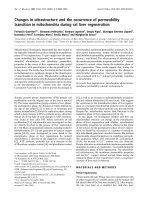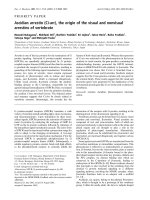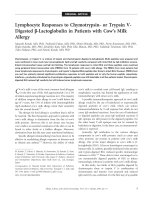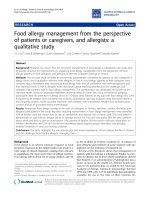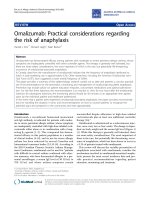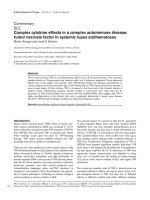Báo cáo y học: "How can we reduce the risk of serious infection for patients with systemic lupus erythematosus" ppt
Bạn đang xem bản rút gọn của tài liệu. Xem và tải ngay bản đầy đủ của tài liệu tại đây (43.21 KB, 2 trang )
Available online />Page 1 of 2
(page number not for citation purposes)
Abstract
Infection is responsible for approximately 25% of all deaths in
patients with systemic lupus erythematosus (SLE), making it a
leading cause of mortality among patients. Ruiz-Irastorza and
colleagues, in a recent issue of Arthritis Research & Therapy,
report the clinical predictors of major infections found in a pros-
pective study of patients with SLE. Similar patterns of infection and
pathogens as reported in previous studies were seen; what is
striking, however, was the protective effect seen with anti-malarial
use. Many infections in patients with SLE could be prevented with
timely vaccinations, reducing exposure to contagious contacts,
screening for latent infections, minimizing exposure to cortico-
steroids, targeted prophylaxis for high risk patients, and, unless
contraindicated, anti-malarial therapy as standard of care.
In a recent issue of Arthritis Research & Therapy, Ruiz-
Irastorza and colleagues [1] report the clinical predictors of
major infections found in a prospective cohort of patients with
systemic lupus erythematosus (SLE) from Spain. The 83
patients with at least one major infection were compared to
166 patients with no major infection history. Major infection is
defined as disseminated, affecting deep organs, requiring
hospital admission for treatment, or causing death. Their
report includes a number of methodological improvements
over previous studies of major infections in patients with SLE,
including its large size, matched SLE controls and longi-
tudinal design.
The reasons behind the high rate of infections seen among
patients with SLE are multi-factorial but many are also
modifiable. Impaired immune system defenses can be caused
by active disease, SLE-associated dysfunction of both innate
and acquired immunity, or by the immunosuppressive
medications used to treat SLE. Additionally, patients have
greater exposure to infectious pathogens, particularly drug-
resistant ones, from proximity to other patients and health
care workers during outpatient and/or inpatient visits.
Infection is responsible for approximately 25% of all deaths in
patients with SLE, making it a leading cause of mortality
among patients with SLE [2,3]. The prevalence of life-
threatening infections appears to be highest within the first
5 years of disease onset [2,4]. Often, the infections that lead
to hospitalization and/or death among patients with SLE are
caused by common pathogens such as Streptococcus
pneumoniae and Haemophilus influenzae, for which effective
vaccinations exist [3]. Therapy for patients with SLE has
shifted to include more use of biologics such as rituximab and
abatacept that increase infection risk in rheumatoid arthritis,
but longer patient exposure is needed to determine if this
shift has altered infection outcomes in SLE [5].
In line with other reports, Ruiz-Irastorza and colleagues found
prednisone use to be associated with infection risk, with each
10 mg per day increase of prednisone increasing the risk of
serious infection 11-fold. Similar patterns of infection and
pathogens as reported in previous studies were seen; what is
striking, however, was the protective effect seen with anti-
malarial use. Most prior studies of predictors of major
infection in SLE did not explicitly look at anti-malarial use and
several lumped anti-malarials into the analysis with other
immunomodulatory medications. Ruiz-Irastorza and colleagues
found that, of the 83 patients with a major infection, 22%
were taking an anti-malarial compared to 77% of patients
matched for time-to-event and age at diagnosis with no major
infection history [1]. In a multivariate model that included
other potential contributing factors for infection, use of anti-
malarials (odds ratio 0.09, 95% confidence interval 0.05 to
0.18) and the duration in months of anti-malarial treatment
Editorial
How can we reduce the risk of serious infection for patients with
systemic lupus erythematosus?
Diane L Kamen
Division of Rheumatology, Medical University of South Carolina, 96 Jonathan Lucas Street, Suite 912, Charleston, South Carolina,
SC 29425-2229, USA
Corresponding author: Diane L Kamen,
Published: 28 October 2009 Arthritis Research & Therapy 2009, 11:129 (doi:10.1186/ar2818)
This article is online at />© 2009 BioMed Central Ltd
See related research by Ruiz-Irastorza et al., />SLE = systemic lupus erythematosus.
Arthritis Research & Therapy Vol 11 No 5 Kamen
Page 2 of 2
(page number not for citation purposes)
(odds ratio 0.991, 95% confidence interval 0.984 to 0.999)
were the strongest predictors of protection against a major
infection. The significance persisted after adjustment for
potential confounders related to anti-malarial treatment,
including markers of SLE severity, since anti-malarials are
more likely to be prescribed to patients with milder disease.
Anti-malarials have a unique mechanism of action in that they
interfere with antigen processing by raising lysosomal pH and
may prevent apoptotic debris from stimulating and sustaining
autoimmunity through inhibition of toll-like receptors 7 and 9.
The anti-malarials are immunomodulatory without being
immunosuppressive in that they downregulate the processing
of low affinity antigens (for example, self peptides) while
preserving the processing of high affinity antigens (for
example, foreign peptides) [6]. The benefits of anti-malarials
in patients with SLE go beyond preventing infection and
include prevention of disease flares and accrual of damage,
with some studies also showing a reduction in vascular and
thrombotic events and improved survival [7]. A review of
evidence published from 95 articles between 1982 and 2007
on the beneficial and adverse effects of anti-malarial drug
therapy in SLE concludes that hydroxychloroquine should be
given to most patients with SLE during the whole course of
the disease, irrespective of severity, and be continued during
pregnancy [6].
Even though the immunologic response may be dampened
by concomitant immunosuppressive medications, it is best
practice to always address immunization status in patients
with SLE regardless of their age or other risk factors. In order
to achieve the highest immunologic response, influenza and
pneumococcus vaccines should be given routinely and
preferably during a time of less intense immunosuppression
and disease activity. Fears of certain vaccinations precipi-
tating SLE exacerbation are based on only weak evidence
[8], while there is excellent evidence that non-live vaccines
are safe and prevent infectious complications among patients
with SLE. Guidelines are in place recommending the
influenza vaccine and pneumococcus vaccine for patients
with rheumatoid arthritis but similar guidelines have not been
developed for SLE. With the exception of the live attenuated
vaccines, other vaccinations should be kept up-to-date in
patients with SLE.
Caring for patients with SLE includes commonsense
measures such as timely vaccinations, reducing exposure to
contagious contacts, screening for latent infections such as
Mycobacterium tuberculosis, minimizing exposure to cortico-
steroids, and targeted re-activation and infection prophylaxis
for high risk patients. Based on an estimated prevalence of
29% for serious infections among patients with SLE and the
findings of Ruiz-Irastorza and colleagues, the number needed
to treat with an anti-malarial to prevent one major infection is
only 4. Growing evidence, now including protection against
major infections, supports the universal use of anti-malarial
drugs as standard of care for all patients with SLE without
contraindications.
Competing interests
The author declares that they have no competing interests.
References
1. Ruiz-Irastorza G, Olivares N, Ruiz-Arruza I, Martinez-Berriotxoa A,
Egurbide MV, Aguirre C: Predictors of major infections in sys-
temic lupus erythematosus. Arthritis Res Ther 2009, 11:R109.
2. Cervera R, Khamashta MA, Font J, Sebastiani GD, Gil A, Lavilla P,
Mejía JC, Aydintug AO, Chwalinska-Sadowska H, de Ramón E,
Fernández-Nebro A, Galeazzi M, Valen M, Mathieu A, Houssiau F,
Caro N, Alba P, Ramos-Casals M, Ingelmo M, Hughes GR; Euro-
pean Working Party on Systemic Lupus Erythematosus: Morbid-
ity and mortality in systemic lupus erythematosus during a
10-year period: a comparison of early and late manifestations
in a cohort of 1,000 patients. Medicine (Baltimore) 2003, 82:
299-308.
3. Goldblatt F, Chambers S, Rahman A, Isenberg DA: Serious
infections in British patients with systemic lupus erythemato-
sus: hospitalisations and mortality. Lupus 2009, 18:682-689.
4. Abu-Shakra M, Urowitz MB, Gladman DD, Gough J: Mortality
studies in systemic lupus erythematosus. Results from a
single center. I. Causes of death. J Rheumatol 1995, 22:1259-
1264.
5. Furst DE, Keystone EC, Kirkham B, Kavanaugh A, Fleischmann R,
Mease P, Breedveld FC, Smolen JS, Kalden JR, Burmester GR,
Braun J, Emery P, Winthrop K, Bresnihan B, De Benedetti F,
Dörner T, Gibofsky A, Schiff MH, Sieper J, Singer N, Van Riel PL,
Weinblatt ME, Weisman MH: Updated consensus statement on
biological agents for the treatment of rheumatic diseases,
2008. Ann Rheum Dis 2008, 67(Suppl 3):iii2-25.
6. Ruiz-Irastorza G, Ramos-Casals M, Brito-Zeron P, Khamashta MA:
Clinical efficacy and side effects of antimalarials in systemic
lupus erythematosus: a systematic review. Ann Rheum Dis
2009, [Epub ahead of print].
7. Alarcon GS, McGwin G, Bertoli AM, Fessler BJ, Calvo-Alen J,
Bastian HM, Vila LM, Reveille JD: Effect of hydroxychloroquine
on the survival of patients with systemic lupus erythemato-
sus: data from LUMINA, a multiethnic US cohort (LUMINA L).
Ann Rheum Dis 2007, 66:1168-1172.
8. Millet A, Decaux O, Perlat A, Grosbois B, Jego P: Systemic lupus
erythematosus and vaccination. Eur J Intern Med 2009, 20:
236-241.

